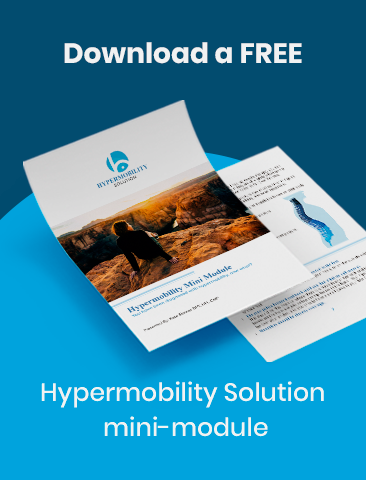As part of my practice as a Hypermobility Doctor in Physical Therapy, I frequently get asked about how to get doctors and the medical community to pay attention to your symptoms.
It sounds crazy.
But as a Hypermobility patient, I can completely relate to this query.
When I was seeking a proper diagnosis years ago, they labeled me a drug user – despite having tested negative on tox screens -an attention seeker, and a whiner.
Someone told me once they “did not work on people like me.” Period.
After years of dealing with this experience and having helped many clients with similar conditions, I have come up with seven tips for talking to your doctor when approaching them about your hypermobility symptoms and treatment.
We'll discuss:
- Start with what you want.
- Summarize your story in two sentences.
- Remember, this is a multi-step process.
- Have your records straight.
- Be smart about your previous diagnosis.
- Don’t straight up disagree with your provider.
- Participate in your care.

Start with what you want.
We all want to walk into an office and have the provider know precisely what our problem is and what the appropriate treatment is and leave happy.
However, even with an open and well-informed doctor, that rarely happens.
The main reason behind this is that physicians don’t know everything about every condition and don’t know your medical history.
That leaves them with little time to manage both things, and they will go with the most common or easiest option first.
As much as it would be ideal to be able to tell your physician the whole story about when your symptoms first appeared and how they evolved, you’ll get much better results if you go straight to the point.
- Questions to ask yourself before meeting with your doctor:
- What is it that brings you there? Do you want a diagnosis? A referral? A test? Or help with acute pain?
- Just pick the most important one and stick to it.
Finally, know what the provider can do for you. If you see a surgeon, he will give you his recommendations about surgery, don’t expect them to order genetic tests.
Summarize your story in two sentences.
Examples of how to explain your story in two sentences:
- “I have had back pain for the last eight years and have already tried PT, medication, chiropractic, etc.”
- “I started having pain when I was 13 in my neck and hips, but now have had difficulty walking the last two years, and it is getting worse.”
These are great ways to give your physician a general idea of your medical history and what you want to get out of that appointment.
Remember, most medical systems focus on efficiency (meaning attending to the maximum number of patients possible), not on the quality of the appointment’s outcome.
Remember, this is a multi-step process.
You must understand this from the beginning of your diagnosis: there’s no easy treatment for hypermobility-related issues.
Having this in mind, you must learn when to push, when to be patient and when to walk away.
My personal and professional advice here is:
- Push when you want a referral or a test, but have a reason behind it.
- Be patient with trying medication or treatments.
- Treatment approaches like physical therapy take some time to see significant long-term effects, so be willing to monitor change over time.
- Walk away and find another physician when you are not moving forward or feeling any progress and when the provider is unwilling to provide the referrals or recommendations you need.
- Remember, there may not be a definitive diagnosis yet for all your issues, and you might have to pursue treatment without a specific name for your condition.
Have your records straight.
Know that if you are in the US, and if you find errors in your medical record, you have the right to have them corrected.
Just consider that this does not include having a provider change a diagnosis that they feel is accurate.
Keep copies of your records and test results. This allows for easier access to provide them to a new provider right away, and not having to repeat previous tests saves you both time and money.
Be smart about your previous diagnosis.
Don't assume everything will relate if you have another label or diagnosis. For instance, if you have fibromyalgia – which can cause widespread body pain – every symptom can be attributed to this, which isn't necessarily correct.
Therefore, when you are dealing with a new physician, you can introduce your situation with something like:
"I know I have been diagnosed with fibromyalgia, and my increased back pain may be related, but because it has changed so much, I would like to be re-evaluated and make sure it is not coming from a new problem."
In this way, you acknowledge the importance or the influence that your previous diagnosis could have on your present symptoms.
Still, you also open the door for ruling out other potential unknown causes.
It may be, but it could also be something different. This way, acknowledging it is good and then asking for an assessment.

Don’t straight up disagree with your provider.
I know… This can be a hard one.
If they offer you medication, don’t say: “I don’t want that.” Taking a minimum dose of a painkiller will not make you addicted for life.
As hard as it can sometimes be, my advice here is that even if you don’t understand your provider’s point of view, try to pause for a moment and allow it to be a discussion.
For example, If you want an MRI and your physician wants you to try Physical Therapy first, ask him what progression he has in mind instead of getting caught in an argument.
If what they have in mind is something like first Physical Therapy and then, if it doesn’t work, MRI, that’s something you could more easily understand and accept.
It may also happen that your insurance requires you to do things in a particular order, or medical protocol recommends a pace of doing things.
You may have to complete things in sequence to get what you want, but it is often in your best interest.
If you have already tried something, speak up and let them know. Sometimes you can skip parts that way.
Participate in your care
Suffering from chronic pain is not easy peasy.
Sometimes you can become overwhelmed that you feel there's no point in sitting in the driver's seat, so you become passive and stop actively seeking more information and trying to understand your condition.
Others can feel frustrated that they become defensive, overactive, and even aggressive.
If you can relate to any of the above, take someone with you to support you and help you advocate for what you want.
Approaching the medical community when you suffer from conditions like Hypermobility can be challenging. Few physicians are well-informed, and it is easy to feel you are not getting the correct answers to your questions.
However, building a support team – that includes medical support – is one of the critical pieces for your long-term progression, which is why we cover it in the Hypermobility Solution online course.
Learn all about Hypermobility Solution here.
If you are interested in learning more, visit my blog, or follow me on Facebook, Instagram & YouTube.
To become part of the online tribe, become part of Kate Skinner's Hypermobility Solution Support Group.
Key takeaway:
Some of the best ways to communicate to your doctor about Hypermobility are:
- Start with what you want.
- Summarize your story in two sentences.
- Remember, this is a multi-step process.
- Have your records straight.
- Be smart about your previous diagnosis.
- Don’t straight up disagree with your provider.
- Participate in your care.

About Kate

Kate Skinner is a Doctor in Physical Therapy, co-founder of Great Divide Physical Therapy, and creator of Hypermobility Solution.
Recent Posts


